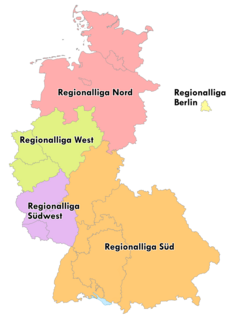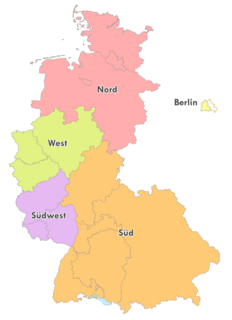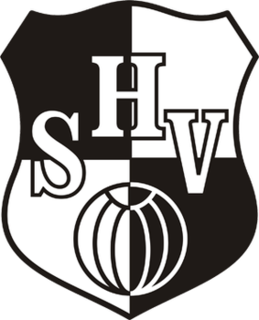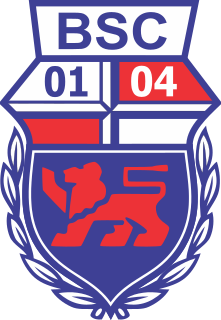The Introduction of the 2. Bundesliga was the step of establishing a professional second tier association football league in Germany in 1974. The new league, the 2. Bundesliga, played its first season in 1974–75 and continues to be the second-highest league in the country. Its introduction reduced the number of second divisions in Germany from five to two and the number of teams at this level from 83 to 40. It eliminated the necessity of having a promotion round at the end of the season to determine the two teams promoted to the Bundesliga.

The 1964–65 Regionalliga was the second Regionalliga season. The league operated in five regional divisions, Berlin, North, South, Southwest and West. The five league champions and the runners-up from the west, south, southwest and north then entered a promotion play-off to determine the two clubs to move up to the Bundesliga for the next season. Western and southern champions Borussia Mönchengladbach and FC Bayern Munich were promoted. Additionally, the third placed team in Berlin, SC Tasmania 1900 Berlin, was also promoted to replace Hertha BSC, which had their Bundesliga licence revoked.

The 1973–74 Regionalliga was the elevent season of the Regionalliga, the second tier of the German football league system. The league operated in five regional divisions, Berlin, North, South, Southwest and West. The five league champions and runners-up then entered a promotion play-off to determine the two clubs to move up to the Bundesliga for the next season. Northern German and Berlin champions Eintracht Braunschweig and Tennis Borussia Berlin were promoted.

The 1972–73 Regionalliga was the tenth season of the Regionalliga, the second tier of the German football league system. The league operated in five regional divisions, Berlin, North, South, Southwest and West. The five league champions and all five runners-up, at the end of the season, entered a promotion play-off to determine the two clubs to move up to the Bundesliga for the next season. Both promotion spots went to the Regionalliga West with Rot-Weiß Essen and Fortuna Köln promoted.

The 1971–72 Regionalliga was the ninth season of the Regionalliga, the second tier of the German football league system. The league operated in five regional divisions, Berlin, North, South, Southwest and West. The five league champions and all five runners-up, at the end of the season, entered a promotion play-off to determine the two clubs to move up to the Bundesliga for the next season. The two promotion spots went to the Regionalliga West and Regionalliga Süd champions Wuppertaler SV and Kickers Offenbach.

The 1970–71 Regionalliga was the eighth season of the Regionalliga, the second tier of the German football league system. The league operated in five regional divisions, Berlin, North, South, Southwest and West. The five league champions and all five runners-up, at the end of the season, entered a promotion play-off to determine the two clubs to move up to the Bundesliga for the next season. The two promotion spots went to the Regionalliga West champions and runners-up VfL Bochum and Fortuna Düsseldorf.

The 1969–70 Regionalliga was the seventh season of the Regionalliga, the second tier of the German football league system. The league operated in five regional divisions, Berlin, North, South, Southwest and West. The five league champions and all five runners-up, at the end of the season, entered a promotion play-off to determine the two clubs to move up to the Bundesliga for the next season. The two promotion spots went to the Regionalliga Süd champions Kickers Offenbach and Regionalliga West runners-up Arminia Bielefeld.

The 1967–68 Regionalliga was the fifth season of the Regionalliga, the second tier of the German football league system. The league operated in five regional divisions, Berlin, North, South, Southwest and West. The five league champions and all five runners-up, at the end of the season, entered a promotion play-off to determine the two clubs to move up to the Bundesliga for the next season. The two promotion spots went to the Regionalliga Berlin champions Hertha BSC Berlin and Regionalliga Süd runners-up Kickers Offenbach.

The 1966–67 Regionalliga was the fourth season of the Regionalliga, the second tier of the German football league system. The league operated in five regional divisions, Berlin, North, South, Southwest and West. The five league champions and all five runners-up, at the end of the season, entered a promotion play-off to determine the two clubs to move up to the Bundesliga for the next season. The two promotion spots went to the Regionalliga Berlin and Regionalliga Südwest champions Alemannia Aachen and Borussia Neunkirchen.

The 1965–66 Regionalliga was the third season of the Regionalliga, the second tier of the German football league system. The league operated in five regional divisions, Berlin, North, South, Southwest and West. The five league champions and four runners-up, the Regionalliga Berlin runners-up was not qualified, entered a promotion play-off to determine the two clubs to move up to the Bundesliga for the next season. The two promotion spots went to the Regionalliga West champions Fortuna Düsseldorf and runners-up Rot-Weiß Essen.

The 1962–63 Oberliga was the eighteenth Oberliga season, the first tier of the football league system in West Germany. The league operated in five regional divisions, Berlin, North, South, Southwest and West. The five league champions and the runners-up from the west, south, southwest and north then entered the 1963 German football championship which was won by Borussia Dortmund. It was Borussia Dortmund's third national championship, having previously won it in 1956 and 1957.

The 1961–62 Oberliga was the seventeenth season of the Oberliga, the first tier of the football league system in West Germany. The league operated in five regional divisions, Berlin, North, South, Southwest and West. The five league champions and the runners-up from the west, south, southwest and north then entered the 1962 German football championship which was won by 1. FC Köln. It was 1. FC Köln's first-ever national championship.

The 1959–60 Oberliga was the fifteenth season of the Oberliga, the first tier of the football league system in West Germany. The league operated in five regional divisions, Berlin, North, South, Southwest and West. The five league champions and the runners-up from the west, south, southwest and north then entered the 1960 German football championship which was won by Hamburger SV. It was Hamburg's fourth national championship and its first since 1928.

The 1957–58 Oberliga was the thirteenth season of the Oberliga, the first tier of the football league system in West Germany. The league operated in five regional divisions, Berlin, North, South, Southwest and West. The five league champions and the runners-up from the west, south, southwest and north then entered the 1959 German football championship which was won by FC Schalke 04. It was Schalke's seventh and last national championship and its first since 1942.

The 1956–57 Oberliga was the twelfth season of the Oberliga, the first tier of the football league system in West Germany and the Saar Protectorate. The league operated in five regional divisions, Berlin, North, South, Southwest and West. The five league champions and the runners-up from the west, south, southwest and north then entered the 1957 German football championship which was won by Borussia Dortmund. It was Borussia Dortmund's second national championship, having won its first in the previous season and thereby becoming the first club to win back-to-back championships since Dresdner SC in 1943 and 1944.

The 1954–55 Oberliga was the tenth season of the Oberliga, the first tier of the football league system in West Germany and the Saar Protectorate. The league operated in five regional divisions, Berlin, North, South, Southwest and West. The five league champions and the runners-up from the west, south, southwest and north then entered the 1955 German football championship which was won by Rot-Weiss Essen. It was Essen's sole national championship while, for losing finalist 1. FC Kaiserslautern, it was the fourth final it played in five seasons.

The 1952–53 Oberliga was the eighth season of the Oberliga, the first tier of the football league system in West Germany and the Saar Protectorate. The league operated in five regional divisions, Berlin, North, South, Southwest and West. The five league champions and the runners-up from the south, north and west then entered the 1953 German football championship which was won by 1. FC Kaiserslautern. It was 1. FC Kaiserslautern's second national championship, having previously won it in 1951.

The 1951–52 Oberliga was the seventh season of the Oberliga, the first tier of the football league system in West Germany and the Saar Protectorate. The league operated in five regional divisions, Berlin, North, South, Southwest and West. The five league champions and the runners-up from the south, north and west then entered the 1952 German football championship which was won by VfB Stuttgart. It was VfB Stuttgart's second national championship, having previously won it in 1950.

The 1948–49 Oberliga was the fourth season of the Oberliga, the first tier of the football league system in the three western zones of Allied-occupied Germany. The league operated in six regional divisions, Berlin, North, South, Southwest and West. The five league champions, the runners-up from the North, South, Southwest and West and the third-placed team from the South entered the 1949 German football championship which was won by VfR Mannheim. It was VfR Mannheim's only national championship.

The 1962–63 2. Oberliga was the fourteenth 2. Oberliga season, the second tier of the football league system in West Germany. The league operated in three regional divisions, South, Southwest and West. In Northern Germany and West Berlin the 2. Oberliga did not existed, local Amateurligas taking their place instead as the second tier of the league system.











